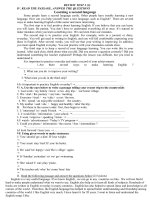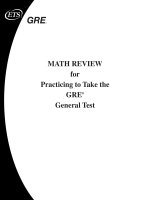SATchem06Kinetics review test
Bạn đang xem bản rút gọn của tài liệu. Xem và tải ngay bản đầy đủ của tài liệu tại đây (261.35 KB, 2 trang )
SC2 – O’Malley
SAT II-Review (Kinetics)
For 1 – 4:
a. Positive H
b. Negative H
c. Positive G
d. Negative G
e. Positive S
1.
2.
3.
4.
Which describes an endothermic
reaction?
Which describes a spontaneous
reaction?
Which describes a
nonspontaneous reaction?
Which is multiplied by temperature
in the equation which calculates
free energy?
For 1 – 4:
a. An increase in the reaction
concentration
b. An increase in temperature
c. A decrease in pressure
d. catalysis
e. pH
Q
14.
15.
16.
17.
18.
19.
20.
21.
22.
23.
24.
25.
26.
5.
6.
7.
Which increases effective collisions
without increasing average kinetic
energy?
Which decreases the activation
energy?
Which increases average kinetic
energy?
For 8 – 10:
a. Enthalpy change
b. Entropy change
c. Gibbs free energy change
d. Activation energy
e. specific heat capacity
8.
Which is the amount of energy that
must be added to raise the
temperature of 1 gram of a
substance 1 oC?
9. Which value indicates the
spontaneity of a reaction?
10. Which value indicates whether a
reaction is endothermic or
exothermic?
Statement I
An increase in entropy leads to a decrease in randomness
In a second order reaction doubling [A] quadruples the rate
Catalysts decrease the rate of a chemical reaction
An exothermic reaction has a positive H value
The entropy of a solid decreases when it is dissolved
If H is positive and S is positive, G must be positive
A catalyst increases the rate of reaction
Increasing the temperature increases the reaction rate
activation energy of a reaction is decreased by a catalyst
The reaction of BaCl2 and Na2SO4 doesn’t go to completion
Catalysts speed up or slow down a reaction
When salt dissolves in water, S for the process is positive
The addition of a catalyst will decrease the H for a reaction
27. For the reaction A + B → C, determine the
order of the reaction with respect to B from
the information given below:
[A]o
[B]o
Initial rate (M/s)
1.00
1.00
2.0
1.00
2.00
8.1
2.00
2.00
15.9
a. Zero order
b. First order
c. Second order
d. Third order
e. Fourth order
28. Which of the following is NOT a true
statement about entropy?
a. Entropy is a measure of the
randomness in a system
b. The entropy of an amorphous solid is
greater than that of a crystalline solid
c. The entropy of a spontaneous
reaction cannot decrease
d. The entropy of an isolated system will
spontaneously increase or remain
constant
e. The entropy of a liquid is greater than
that of a solid
29. A catalyst
a. changes G for an equation
b. acts by increasing the rate of the
forward reaction more than the
reverse reaction
c.
d.
e.
Because
Because
Because
Because
Because
Because
Because
Because
Because
Because
Because
Because
Because
Because
For 11 – 13:
a. 0
b. 1
c. 2
d. 3
e. 4
Based on the following reaction and rate
data:
A(g) + B(g) → products
Experiment [A]
[B]
Initial
mol/L
mol/L
rate
(M/s)
1
0.060
0.010
0.040
2
0.030
0.010
0.040
3
0.030
0.020
0.080
11. What is the order of the reaction
with respect to A?
12. What is the order of the reaction
with respect to B?
13. What is the rate constant?
Statement II
The low energy state of ordered crystals has a high entropy
The rate equation is r=k[A]2 for such a reaction
Catalysts decrease activation energy
Heat must be added to the reaction for the reaction to occur
It becomes less ordered
G = H – TS
It raises the energy of the products
At high temperatures, molecules or atoms tend to be further apart
It is not used up in the process
The compound barium sulfate is formed
Catalysts change the energy released from a reaction
Aqueous ions have a greater entropy than ions in a solid
Catalysts provide alternate reaction paths with lower activation energy
raises the equilibrium constant of a
system
may have molecular weight as low as
1 or higher than 200,000
does not react chemically during the
course of a reaction
30. For which of the following is there an
increase in entropy?
a. Na(s) + H2O(l) → NaOH(aq) + H2(g)
b. I2(g) → I2(s)
c. H2SO4(aq) + Ba(OH)2(aq) →
BaSO4(s) + H2O(l)
d. H2(g) + ½ O2(g) → H2O(l)
e. None of the above
31. Which of the following conditions
guarantee a spontaneous reaction?
a. positive H, positive S
b. positive H, negative S
c. negative H, negative S
d. negative H, positive S
e. none of the above
32. A reaction that occurs only when heat is
added is best described as
a. Exothermic
b. Endothermic
c. An equilibrium process
d. Spontaneous
e. Non-spontaneous
33. The important considerations in deciding
if a reaction will be spontaneous are
a. stability & state of reactants
b. energy gained & heat evolved
c. exothermic energy & randomness
of the products
d. endothermic energy & randomness
of the products
e. endothermic energy & structure of
the products
34. In a multistep chemical process, the
rate-limiting step is the step in the
reaction with the
a. Highest activation energy & fastest
reaction rate
b. Highest activation energy &
slowest reaction rate
c. Lowest activation energy & fastest
reaction rate
d. Lowest activation energy & slowest
reaction rate
e. Greatest concentration of the
reactants and products
35. Which of the following reactions shows
a decrease in entropy?
a. C(s) + 2H2(g) → CH4(g)
b. H2O(g) → H2(g) + ½ O2(g)
c. 2NI3(s) → N2(g) + 3I2(g)
d. 2O3(g) → 3O2(g)
e. none of the above
answers:
1.
2.
3.
4.
5.
6.
7.
8.
9.
10.
11.
12.
13.
14.
15.
16.
17.
18.
19.
20.
21.
22.
23.
24.
25.
26.
27.
28.
29.
30.
31.
32.
33.
34.
35.
A
D
C
E
A
D
B
E
C
A
A
B
E
F, F
T, T, CE
F, T
F, F
F, T
F, T
T, F
T, T
T, T
F, T
F, F
T, T
F, T
C
C
D
A
D
B
C
B
A









